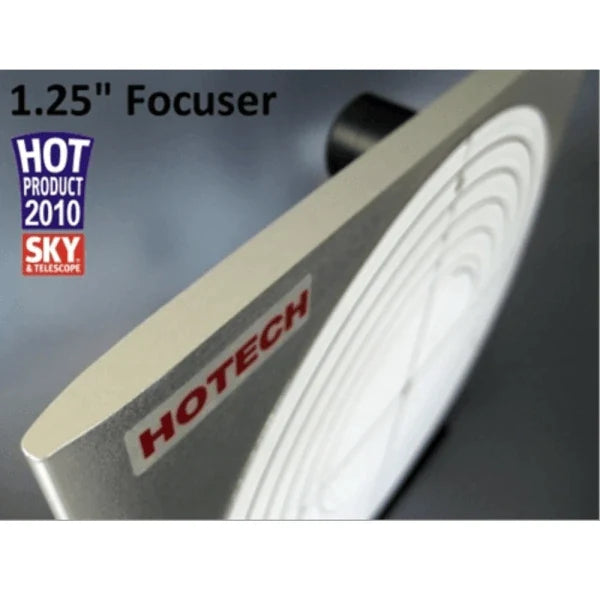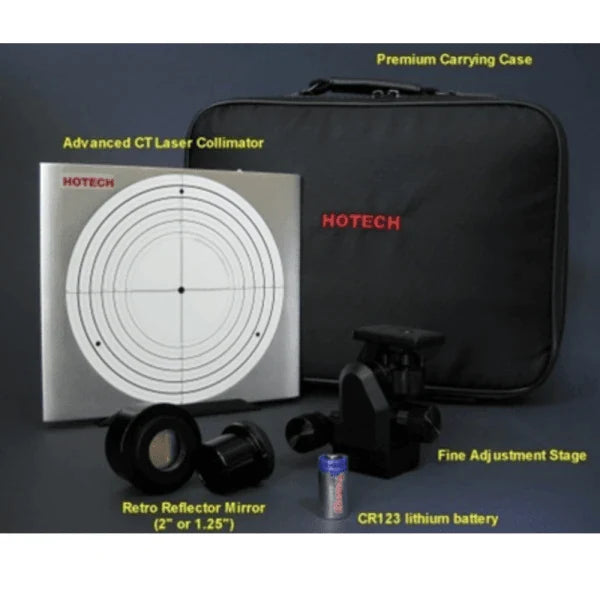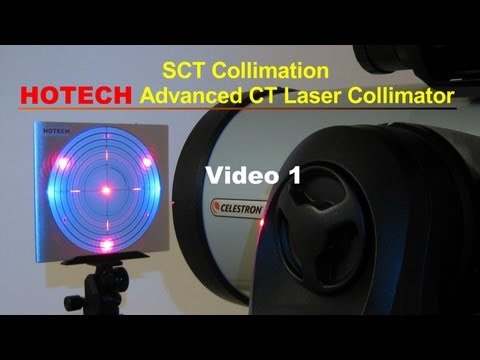HoTech Advanced CT Laser Collimator for 1.25" Focuser
Innovation Brings Affordable and Portable Collimation Into Reality
Since the invention of the Cassegrain Telescope in 1672 by the French sculptor Sieur Guillaume Cassegrain, the Cassegrain Telescope has evolved into various derivative designs such as the more popular Ritchey-Chrétien, Dall-Kirkham, Schmidt-Cassegrain, and Maksutov-Cassegrain. The designs have gained their popularity because of their compact and simple to produce design. With different designs, star collimation is and has always been the only effective method to collimate for Cassegrain telescope owners.
Now, backyard astronomers have an alternative to achieve excellent collimation conveniently using the HoTech Advanced CT Laser Collimator for 1.25″ Focuser. The Advanced CT Laser Collimator brings the collimating star to your telescope within arm reaching distance. With its short-range capability, you can perform collimation indoors – day or night – without being subjected to weather conditions. And best of all, this new collimator utilizes a clear and simple-to-read, large target display for the telescope alignment diagnostic. This large target display is positioned within a short focal distance of the telescope which allows you to collimate without guessing.
No Star Required to Collimate
In order to achieve an accurate star collimation, normally the amateur astronomer requires good seeing conditions with no cloud, no wind, stable temperature, no light pollution, a well-aligned telescope mount tracking system, telescope optical tube assemble (OTA) thermal equilibrium, and a good visible magnitude star. The visual quality of the referencing star is greatly affected by the prescribed factors most of which are all in Gods hand as you can see in the photo. Adjusting the collimation is guessing game where you move between front and the back of the telescope adjusting the corresponding alignment screw and holding your breath peeping through a high magnification eyepiece referencing the concentricity of the unstable defocused image. This can be an incredibly frustrating experience. An artificial star can never simulate a real star because it is impossible to collimate with the telescope focus set at infinity. After artificial star collimation, you will need to adjust your focus back to infinity to view a real star by moving the primary mirror to a different position. The distance the primary mirror has been adjusted can accumulate mechanical tolerance errors. For some of the mass-produced SCTs, the “sticky baffle” on the primary mirror focusing mechanism may also cause mirror-flop. If a mirror-flop has occurred, it will affect the alignment position which in turn will render the collimation useless. Ideally, It is best to collimate your optics at the same viewing focusing position without major optical displacements to correspond to the final view setting. The Advanced CT Laser Collimator can accomplish this task without all the possible accumulated errors. The large target display on the Advanced CT Laser Collimator brings you a clear visual cue of three projecting laser dots as the alignment reference at a very comfortable visual distance providing an accurate axial alignment error diagnostic. And during the entire collimation process, no major focusing is needed, thus minimizing the possible accumulated errors from the focusing adjustments. The referencing adjustments are made by bringing the three clearly discernable projected laser dots, projected on the target, into a concentric ring. No more peeping through the eyepiece looking for a changing, ambiguous star image. This alternative collimation method saves precious observing time by collimating the telescope and preparing the viewing programs at dusk or before dawn without the influences of the external environmental conditions.
Collimate Within Focal Distance From Your Telescope
The Advanced CT Laser Collimator does not require long focal distances to achieve high-accuracy collimation. Utilizing the installed flat mirror at the focal point (eyepiece location), the collimator lasers double-passes both your primary and secondary mirrors and magnifies the alignment errors to a higher accuracy level. In addition, it also cuts the collimating distance in half-achieving near-field alignment process. The collimator is stationed within your telescope's focal length directly in front of your telescope. Setting up for collimation, you will be standing between the telescope and the collimator aiming both the telescope and the collimator at each other. Then you will adjust the secondary mirror knob to bring the returning lasers on the same track. This is a very convenient one-man operation.
At a Fraction of the Cost of Wavefront Interferometer Technology
The state-of-the-art advanced laser optical alignment technology used in the Advanced CT Laser Collimator achieves the same rough alignment function of a costly large aperture interferometer commonly use in high-energy labs at a fraction of its cost.  The Advanced CT Laser Collimator uses three collimated lasers, evenly spaced apart, to sample large aperture optical elements in your telescope. The three parallel laser beams completely simulate the light path (flat-wavefront) from a distant star and pass through the entire telescope’s optical elements and reflect back to its target for a complete and accurate double-pass diagnostic reading of your telescope optical alignment. This innovative collimation technique and technology enables the amateur astronomer achieving far-field collimation as a near-field process.
The Advanced CT Laser Collimator uses three collimated lasers, evenly spaced apart, to sample large aperture optical elements in your telescope. The three parallel laser beams completely simulate the light path (flat-wavefront) from a distant star and pass through the entire telescope’s optical elements and reflect back to its target for a complete and accurate double-pass diagnostic reading of your telescope optical alignment. This innovative collimation technique and technology enables the amateur astronomer achieving far-field collimation as a near-field process.
Precision CNC Machined Panel and Components
This beautifully designed instrument is precision machined from a solid block of aero-space grade aluminum. It is then hardened and anodized to keep the entire mounted laser system thermally stable allowing you to achieve accurate collimation. The rigid, ultra-thin profile, and light-weight design makes the unit portable and simple to setup and use.
Collimates All CT, SCT, Makustov & RC
The Advanced CT Laser Collimator simulates a real distant star light path, and as a result it can collimate most telescopes which primarily rely on star collimation. The collimation technique can be implemented on any size telescope. The current production model is designed to collimate telescopes with a primary mirror greater than 7-1/5-inches and a secondary mirror obstruction diameter less than 6-1/2-inches. For other larger sized telescope or for custom sizes, contact us.
Additional Features:
Collimate Your Cassegrain Telescope
- Without using a star
- Indoor or outdoor – day or night
- Focus stays at final view setting
- Within focal distance from your telescope
- One-man operation
- Portable and simple to setup and use
- Works on CT, SCT, SN Mak, & RC






 The Advanced CT Laser Collimator uses three collimated lasers, evenly spaced apart, to sample large aperture optical elements in your telescope. The three parallel laser beams completely simulate the light path (flat-wavefront) from a distant star and pass through the entire telescope’s optical elements and reflect back to its target for a complete and accurate double-pass diagnostic reading of your telescope optical alignment. This innovative collimation technique and technology enables the amateur astronomer achieving far-field collimation as a near-field process.
The Advanced CT Laser Collimator uses three collimated lasers, evenly spaced apart, to sample large aperture optical elements in your telescope. The three parallel laser beams completely simulate the light path (flat-wavefront) from a distant star and pass through the entire telescope’s optical elements and reflect back to its target for a complete and accurate double-pass diagnostic reading of your telescope optical alignment. This innovative collimation technique and technology enables the amateur astronomer achieving far-field collimation as a near-field process.